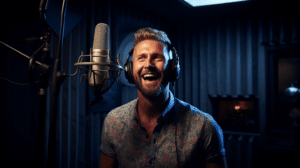In the fast-paced marketing world, where attention spans are fleeting, radio commercials have stood the test of time as a powerful tool for capturing and engaging audiences. But what is the secret behind creating truly effective radio ads? Join us as we delve into the science behind crafting impactful commercials that leave a lasting impression. This article explores critical elements and future trends in radio advertising, from persuasive copywriting to distinctive voiceovers and memorable jingles.
Important Highlights from the Content
- Radio advertising engages audiences through sound, standing out in a visually saturated world.
- The critical elements of impactful radio ads are catchy, memorable jingles and the right voice talent.
- Persuasive copywriting, thorough research, and collaboration with radio production experts are essential for effective campaigns.
- Distinctive voiceovers and well-crafted jingles increase brand recognition, recall, and emotional connection with listeners.
Understanding the Power of Radio Advertising
The effectiveness of radio advertising lies in its ability to captivate audiences through the power of sound. In a world inundated with visual stimuli, radio advertising stands out by engaging listeners through carefully crafted audio messages. To create impactful radio commercials,
Radio ad production involves various elements, including radio voiceovers, jingle production, sweepers, and spot production. Each component plays a crucial role in creating a memorable and persuasive advertisement. The voiceover artist brings the script to life, using their vocal skills to convey the desired message. Jingles add a catchy and memorable tune, creating an earworm that lingers in listeners’ minds long after the commercial has ended. Radio sweepers provide transitions between segments, maintaining the flow of the radio broadcast. Finally, radio spot production ensures the commercial is effectively timed and placed within the radio program.
Critical Elements of an Impactful Radio Ad
One of the key elements in crafting a radio ad that leaves a lasting impact is engaging the audience through compelling storytelling and persuasive messaging. To achieve this, several components need to come together seamlessly:
- Jingle Writing: A catchy and memorable jingle can instantly capture listeners’ attention and create brand recognition. Incorporating a well-crafted song into a radio ad can reinforce the brand’s message and leave a lasting impression.
- Voice Over: The right voice talent can bring the script to life and establish a connection with the audience. A professional radio production should carefully select a voice that matches the tone and target audience of the ad, ensuring an emotional connection is made.
- Creative Radio Production: A well-produced radio ad goes beyond words and voice. Sound effects, music, and other audio elements can enhance the storytelling and create a more immersive listening experience.
The Art of Persuasive Copywriting for Radio
Crafting persuasive copy for radio requires a deep understanding of the target audience’s desires and motivations. In the world of advertising on radio, where attention spans are short, and competition is fierce, it is essential to create compelling messages that resonate with listeners. To achieve this, radio ad scriptwriting must be approached as an art form, combining creativity and persuasion to deliver impactful results.
Effective radio advertising campaigns are built on thorough research and analysis. The Radio Advertising Bureau provides valuable insights and resources to help advertisers understand the medium and its audience. By studying advertising case studies and learning from the successes of others, advertisers can gain valuable insights into what works and what doesn’t in the world of radio advertising.
Once armed with this knowledge, radio ad campaign management becomes a strategic process. It involves carefully crafting the message, considering the target audience’s desires and motivations, and selecting the right tone and language to connect with them. Collaboration with radio production experts can also ensure the final product is of the highest quality.
The Role of Distinctive Voiceovers in Radio Ads

- Memorability: A unique voice can make a brand stand out. Radio ads can leave a lasting impact on the consumer by using a distinct and memorable voice, increasing brand recognition and recall.
- Engagement: The right voice can captivate audiences, drawing them into the ad and keeping them engaged from start to finish. A skilled voice actor knows how to infuse the right tone, pace, and emotion into their delivery, effectively connecting with the listener on an emotional level.
- Brand Consistency: Voiceovers provide an opportunity to reinforce a brand’s identity. Whether it’s a warm and friendly voice for on-hold messaging or a bold and authoritative voice for custom radio commercials, a consistent voice helps create a cohesive brand experience across different advertising channels.
Crafting Memorable Jingles: A Science in Itself
Developing memorable jingles requires careful attention to melody, lyrics, and rhythm, as these elements are vital in creating a lasting impact on the listener. In today’s advertising landscape, where attention spans are short, and consumer behaviors constantly change, radio production companies and studios understand the importance of crafting jingles that stand out and resonate with the audience.
Music is crucial in capturing the listener’s attention right from the start. For example, the intro and outro for podcast episodes rely on catchy jingles to create a memorable experience. Using rhythmic patterns and melodic hooks, jingles can instantly grab the listener’s attention and leave a lasting impression.
The lyrics of a jingle are equally important. They should be simple, easy to remember, and effectively convey the brand’s message. A well-crafted song can communicate a brand’s values and unique selling points and create a sense of familiarity and trust with the audience.
Timing is also a critical consideration when developing jingles. It is essential to strike the right balance between the length of the song and the time available for the advertisement. A concise yet impactful piece can significantly impact the listener, even within a short period.
The Importance of a Clear Call-to-Action in Radio Commercials
A clear call to action is essential in radio advertisements as it directs the audience on what specific action to take after hearing the commercial. Radio commercial producers understand the importance of a solid call to action in driving results and maximizing the return on investment
- A compelling and persuasive message that resonates with the target audience.
- Engaging radio ad voice actors who can deliver the message in a captivating and memorable way.
- Well-crafted radio ad copywriting that grabs attention and highlights the benefits of the product or service being advertised.
Radio advertisement production goes beyond just creating an ad; it involves radio spot development and optimization to ensure that the commercial reaches the right audience at the right time. Radio branding solutions are also considered to create a consistent and recognizable brand identity across different ad campaigns.
Best Practices for Radio Jingle Production
When producing radio jingles, it is essential to create catchy and memorable melodies that resonate with the target audience. Radio production companies and studios understand the power of a well-crafted lyric in capturing listeners’ attention and leaving a lasting impression. A catchy song can stick in people’s minds, making it an effective tool for advertising in the audio medium.
To create a memorable jingle, it is essential to consider the target audience and the brand’s message. The song should reflect the brand’s personality and values while appealing to the intended listeners. Sound effects and unique musical elements can enhance the jingle’s impact.
Radio campaigns are an essential part of marketing channels in the advertising industry. Audio ads, including jingles, effectively reach a broad audience and promote brand recognition. They can be used as the outro for a podcast or as standalone advertisements on radio stations.
Overall, a well-produced jingle can make a significant difference in the success of a radio campaign. It is a powerful tool that radio production companies and studios utilize to create memorable and persuasive advertisements that captivate listeners and leave a lasting impression.
Integrating Radio Ads Into Your Broader Marketing Strategy
Integrating radio ads into a broader marketing strategy requires careful consideration of target demographics and brand messaging. Radio advertising remains a powerful tool for reaching a wide audience and creating emotional engagement through the audio experience. Here are three key factors to consider when incorporating radio ads into your marketing strategy:
- Target demographics: Understanding your target audience is crucial. Research their listening habits and preferences to ensure your ads reach the right people at the right time.
- Brand messaging: Craft a clear, compelling message that aligns with your brand strategy. Focus on creating a memorable and impactful ad that resonates with listeners.
- Digital platforms: Utilize digital media to enhance your radio ads. Consider creating a solid intro and outro for podcast episodes, seamlessly integrating your brand message, and directing listeners to your website or social media channels.
Measuring the Effectiveness of Radio Ads
Measuring the impact of radio ads involves analyzing key performance indicators to determine the campaign’s success and make data-driven decisions for future marketing strategies. By tracking metrics such as reach, frequency, and conversions, radio production companies can assess the effectiveness of their commercials in reaching potential customers and influencing their purchasing decisions.
To provide a comprehensive understanding of the effectiveness of radio ads, let’s take a look at the following table:
| Key Performance Indicator | Description |
|---|---|
| Reach | The number of unique listeners who hear the ad |
| Frequency | The average number of times the ad is heard by each listener |
| Conversions | The number of desired actions taken by listeners as a result of hearing the ad |
| Consumer Perception | The overall opinion and attitude of listeners towards the ad |
| Audience Engagement | The level of interaction and involvement of listeners with the ad |
By carefully analyzing these KPIs, radio production companies can gain insights into the effectiveness of their advertising processing strategies. They can then make data-driven decisions to optimize their radio advertising creativity, improve consumer perception, and enhance audience engagement.
Furthermore, the role of sound designers in creating effective radio commercials cannot be underestimated. They use their expertise to create captivating auditory experiences, incorporating sonic logos to enhance brand recognition and recall. Through their creativity, sound designers play a crucial role in ensuring that radio ads leave a lasting impact on listeners and drive desired actions.
Case Study: Successful Radio Ad Campaigns
Case studies of radio ad campaigns that have achieved significant success provide valuable insights into advertisers’ strategies and techniques to effectively engage listeners and drive desired outcomes. In the dynamic marketing environment, radio production companies strive to create high-quality radio ads that leave a lasting impression on consumers.
Here are three key elements that have contributed to the success of notable radio ad campaigns:
- Catchy slogans: Advertising for decades has proven that memorable slogans are a powerful tool for consumer recall. These short and catchy phrases encapsulate the essence of a brand or product, making it easier for listeners to remember and identify with the ad.
- Recognizable advertising jingles: Jingles in advertising have stood the test of time. These melodic tunes capture attention and create a strong association with a brand. When a song is well-crafted, it becomes instantly recognizable and helps to reinforce brand recognition and recall.
- Dynamic storytelling: Successful radio ad campaigns often incorporate storytelling techniques that captivate listeners. By creating relatable characters or situations, advertisers can connect with their audience on an emotional level. This approach helps to engage listeners and makes the ad more memorable.
Future Trends in Radio Advertising
As technology advances, radio advertising adapts to new trends and explores innovative ways to engage with audiences. Radio production companies are embracing online platforms and streaming services to reach a wider audience and tap into the potential of digital advertising. With the evolving marketing landscape and changing customer behavior, radio advertisers are finding new ways to increase engagement and optimize their campaigns.
One of the critical trends in radio advertising is the shift toward audio marketing. With the rise of podcasts and voice assistants, there is a growing demand for audio content. Radio advertisers leverage this trend by creating engaging and compelling audio commercials that resonate with listeners.
To emphasize the importance of innovation in radio advertising, consider the following table:
| Trends in Radio Advertising | Benefits |
|---|---|
| Embracing online platforms | Expanded reach and targeting capabilities |
| Utilizing streaming services | Access to a younger and tech-savvy audience |
| Incorporating digital advertising | Enhanced measurement and tracking capabilities |
| Adapting to changing customer behavior | Increased relevance and personalization |
| Investing in audio marketing | Higher engagement levels and brand recall |
Frequently Asked Questions
How Much Does It Cost to Produce a Radio Commercial?
The cost of producing a radio commercial can vary depending on various factors, such as the commercial’s length, the content’s complexity, and the production values involved. Factors like hiring voice actors, recording and editing equipment, and licensing music or sound effects fees can also contribute to the overall cost. It’s essential for businesses to carefully consider their budget and goals when determining how much to invest in producing a radio commercial that effectively reaches their target audience.
How Long Should a Radio Commercial Be?
Several factors should be considered when determining the length of a radio commercial. The primary goal is to capture the audience’s attention and deliver the intended message effectively. Research suggests that shorter commercials, typically around 15 to 30 seconds, tend to be more successful in retaining listeners’ attention and conveying the message concisely. However, longer commercials, ranging from 60 to 90 seconds, can be effective for specific products or services that require more detailed explanations. Ultimately, the ideal length depends on the target audience, the product/service being advertised, and the specific goals of the commercial.
What Is the Average Reach of a Radio Ad Campaign?
The average reach of a radio ad campaign refers to the number of people exposed to the advertisement. It is a key metric used to measure the effectiveness and success of a radio campaign. The reach can vary depending on the target audience, time of day, and the radio station’s audience demographics. By analyzing the average distance, advertisers can evaluate the campaign’s performance and make informed decisions about future strategies.
How Can I Target a Specific Audience With My Radio Commercial?
When targeting a specific audience with your radio commercial, it is essential to understand your target market’s demographics, interests, and preferences. By conducting market research and analyzing data, you can identify the proper radio stations and time slots that align with your audience’s listening habits. Additionally, tailoring your message to resonate with your target audience’s needs and aspirations will increase the effectiveness of your radio commercial in capturing their attention and driving desired actions.
Can I Use Licensed Music in My Radio Jingle?
Yes, you can use licensed music in your radio jingle, but it is essential to consider the legal implications. Using licensed music requires obtaining permission from the copyright holder and potentially paying royalties. It is advisable to consult with a legal professional or a licensing agency to ensure compliance with copyright laws. Additionally, using licensed music can enhance the effectiveness of your radio jingle by leveraging familiar melodies and catchy tunes that resonate with your target audience.
Conclusion
Radio advertising has been an effective tool for marketers for decades and remains vital to any successful advertising strategy. Radio commercials are an effective way to reach a large, diverse audience in a short period. With the emergence of new media, such as jingle podcasts and jingle TV, jingles are becoming an even more important part of radio marketing. By creating catchy and memorable songs, marketers can increase their reach and create an emotional reaction among the average listener.
The key to a successful radio ad campaign is understanding the power of radio and how it can be used to deliver a simple message to a targeted audience. The right audio message and the correct frequency and time frame to broadcast the ad are essential for a successful campaign. Additionally, finding the perfect voiceover and marking mix to create a memorable campaign is a critical part of the process.
Finally, measuring the effectiveness of the campaign is a crucial step. By understanding the impact of radio ads on their target audience and tracking how radio listening habits change over time, marketers can optimize their campaigns to maximize their reach and effectiveness.
In conclusion, the science of creating effective radio commercials involves understanding the power of radio advertising, incorporating key elements such as persuasive copywriting and distinctive voiceovers, crafting memorable jingles, integrating radio ads into a broader marketing strategy, and measuring their effectiveness. By studying successful radio ad campaigns and keeping an eye on future trends, marketers can continuously improve their radio advertising techniques and connect with their target audience in a memorable and impactful way. Keywords: jingle podcast, jingle TV, jingles for sale, average listener, marking mix, emotional reaction, radio listening, radio message, period, time frame, simple message, essential component.


Recent Comments